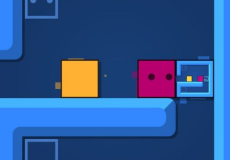

Tungtung’s Nightmare

Tungtung’s Nightmare is a surreal horror game built around a single, deceptively simple task: wake up and gather food for suhoor, the pre-dawn meal in Ramadan. But what begins as a quiet nightly routine quickly transforms into a frantic run for survival as you’re hunted by bizarre, human-sized sausage-like beings with wide eyes and crooked smiles. The game’s setting, humor, and horror elements are directly inspired by the viral Indonesian meme “Tungtungtung Sahur,” turning a cultural joke into an interactive nightmare where skipping a meal has real consequences.
The game opens with a dimly lit bedroom. A phone alarm rings, showing the message: “It’s time for Suhoor.” The tone is harmless, familiar—but ignoring the alarm starts the nightmare. The moment you choose to return to sleep instead of preparing your meal, a sequence of increasingly disturbing events unfolds. Your surroundings grow darker. The space around you stretches into an empty, cold apartment. And then comes the sound—rhythmic, loud, unmistakable—Tungtung’s call.
The Game’s Concept and Mechanics
Tungtung’s Nightmare uses a simple structure: you must collect six food items and bring them back to a dining table before a terrifying entity catches you. Each food item is scattered across a shadowy, minimalist apartment. The room layouts are basic—tables, stools, long hallways—but the darkness and unsettling silence make the space feel endless. A flashlight guides your way, but it barely lights up more than a few steps ahead.
There are no traditional weapons or health bars. Instead, the primary threat is a creature called Tungtung, based on the meme’s titular character. He and his copies roam the halls, sometimes silently, sometimes announcing their presence with slow, stomping steps. If you’re spotted, a chase begins—and you have only seconds to find a safe corner or outrun them. The tension builds from knowing that even when things seem quiet, Tungtung could be waiting just around the next corner.
Players must balance speed with caution. Rushing into rooms may get you the next meal item faster, but it also increases the risk of being spotted. Hiding in darkness works temporarily, but Tungtung seems to learn over time. Each failed attempt teaches you something new about the AI’s patterns, the layout of the apartment, and the best routes to collect food without being cornered.
A Horror Game With Cultural Humor
What makes Tungtung’s Nightmare stand out from other indie horror games is its origin in online humor. The meme it’s based on went viral for dramatizing the act of waking someone up for sahur with over-the-top horror effects and loud sound design. In reality, people often knock on doors, bang pots, or use loudspeakers to make sure no one oversleeps and misses this crucial meal. The game captures that concept perfectly: failing to wake up results in being hunted by exaggerated versions of the very people who would try to help.
Tungtung himself looks like a humanoid sausage with a permanent, forced grin and long arms swinging awkwardly at his sides. His uncanny design walks the line between funny and unnerving, creating a character that doesn’t need detailed backstory or voice lines to be threatening. His cartoonish expression and slow, puppet-like walk add to the absurd tension. He is the meme made real—and in this game, he’s not here to remind you. He’s here to make sure you never forget.
The sound design supports this balance between absurdity and horror. The sound of footsteps echo unnaturally in the empty apartment. Distant knocking grows louder if you hesitate too long. When Tungtung appears, the audio distorts, and a signature drum beat (a reference to the original meme) begins to play, signaling that your time is running out.
Layers of Simplicity and Satire
Though the gameplay loop is straightforward—wake up, find food, avoid death—Tungtung’s Nightmare makes creative use of repetition and limitation. There’s no tutorial, no objective marker beyond “0/6” written on the dining table. The apartment isn’t procedurally generated, but its sparse design and dark palette make every room feel slightly different on each attempt. It becomes a mental map the player builds over time.
There’s also an element of social commentary hidden behind the meme. Missing sahur in real life isn’t just inconvenient—it can make fasting more difficult, especially for young people. The game turns this idea into a punishment system: the later you are, the more aggressive Tungtung becomes. He isn’t just a monster. He’s a loud reminder of routine, responsibility, and the consequences of ignoring them.
Despite being short in length—an experienced player might complete it in under ten minutes—the game encourages multiple attempts through trial and error. The chase mechanics aren’t scripted, and the AI’s behavior changes slightly each round. With each run, you get better at managing time, predicting danger, and planning your path. It becomes a rhythm: grab the food, return to the table, check the hallway, move again.
Key Features
- Inspired by Meme Culture: Based on the viral “Tungtungtung Sahur” meme from Indonesia, turning a humorous concept into a horror experience.
- Simple but Effective Gameplay: Search, collect, and escape—all while being pursued by unpredictable enemies.
- Audio Cues and Tension: Use sound to know when to move or hide. Silence doesn’t mean safety.
- Cultural Context: Integrates real-world Ramadan practices into its mechanics, making it both absurd and meaningful.
- Replayable Format: Short length with randomized enemy movement and a focus on learning through repetition.
Final Thoughts
Tungtung’s Nightmare is a strange mix of meme-based horror and minimalist game design that works surprisingly well. It doesn’t rely on jump scares or flashy visuals—instead, it builds tension through quiet spaces, cultural references, and a single creature that grows more threatening the longer you play. It’s a reminder that even the smallest tasks—like getting up for suhoor—can become overwhelming when ignored.
Whether you’re familiar with the meme or experiencing it for the first time, the game delivers an oddly memorable experience: part satire, part survival, and completely unsettling. There’s no cutscene to explain what’s happening, and no victory screen to congratulate you. You just collect your food, return to the table, and wait for the nightmare to end.
Unless you sleep through it again.
Discuss Tungtung’s Nightmare














